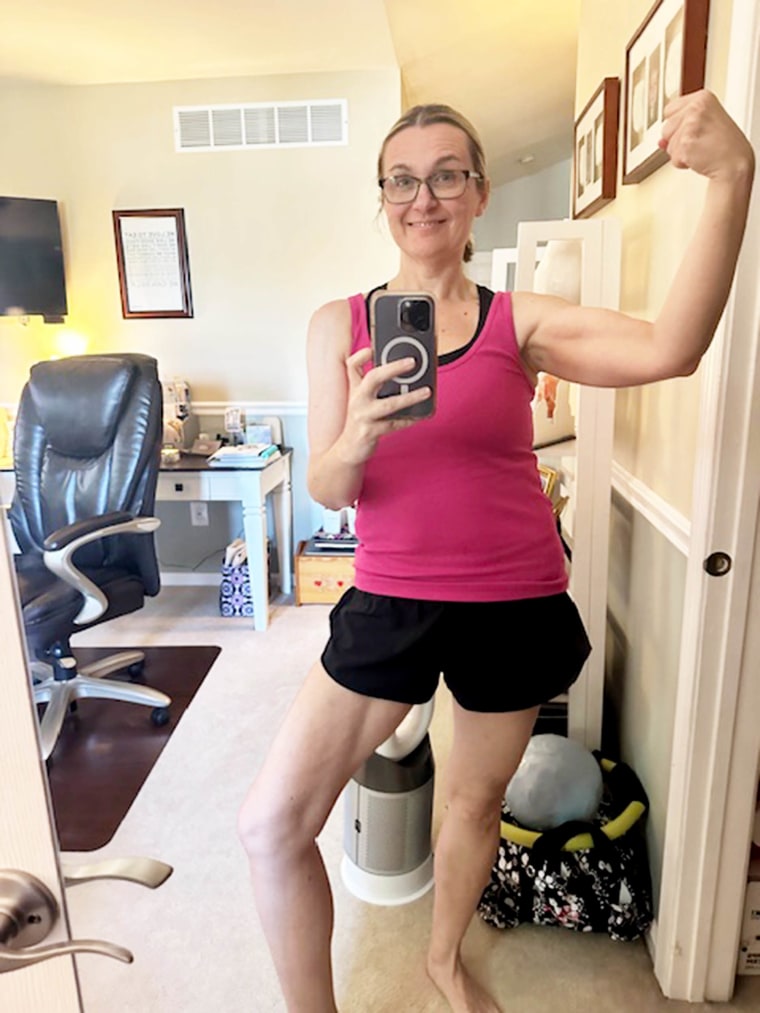Jennifer Lynn-Pullman is a certified specialist in obesity and weight management, so she was frustrated when her own weight kept rising over the years.
“I had struggled with my weight for a long time. My whole family struggles as well, so it’s very genetic,” Lynn-Pullman, 48, a registered dietitian and manager of clinical dietetics for Vida Health, tells TODAY.com.
“And of course, in your 40s with perimenopause, it doesn’t get any easier.”
Lynn-Pullman, who lives in suburban Philadelphia, was alarmed when her cholesterol went up for the first time two years ago and her A1C — a measure of blood sugar — was trending up.
At 5 feet, 6 inches tall, she weighed 200 pounds and worried she was on track to develop Type 2 diabetes in her 50s like her parents.
Her doctor prescribed Wegovy, the version of Ozempic approved for weight loss. It’s part of the GLP-1 class of medications that mimic a hormone the body produces after eating to decrease appetite and help the body manage insulin production.
 Dietitian Jennifer Lynn-Pullman weighed 200 pounds at her heaviest.Courtesy Jennifer Lynn-Pullman
Dietitian Jennifer Lynn-Pullman weighed 200 pounds at her heaviest.Courtesy Jennifer Lynn-Pullman
After starting the drug in 2023, Lynn-Pullman lost 60 pounds in 10 months and has maintained that weight for more than a year.
Like many patients, she experienced side effects and had to figure out which foods to avoid on a GLP-1 and how to prevent muscle loss.
Here are her tips for eating on a GLP-1 based on her own experience:
How She Manages Nausea and Vomiting
Lynn-Pullman had side effects for the first six months, usually when her medication dosage was increased.
GLP-1 drugs slow stomach emptying, one of the reasons patients can experience uncomfortable symptoms. Nausea and vomiting are some of the most common side effects.
For nausea, Lynn-Pullman prefers to use ginger gum. She also prepares easy to digest foods like a smoothie, soup and crackers that aren’t too heavy for her stomach.
Vomiting is usually due to eating too much or consuming high-fat foods, so she advises eating smaller meals, not eating too fast and avoiding greasy foods.
“Fat just stays in your stomach longer,” she says. “With someone whose stomach is emptying much slower, it causes more of an upset.”
Lynn-Pullman realized her vomiting episodes were caused by high-fiber muffins she was eating to help ease constipation. Once she cut them out, the problem stopped.
 Lynn-Pullman has lost 60 pounds and maintained that weight loss for more than a year.Courtesy Jennifer Lynn-PullmanWhat She Eats for Breakfast, Lunch and Dinner
Lynn-Pullman has lost 60 pounds and maintained that weight loss for more than a year.Courtesy Jennifer Lynn-PullmanWhat She Eats for Breakfast, Lunch and Dinner
The dietitian decided to treat herself like her bariatric surgery patients.
“I realized that because Wegovy causes such an increased level of satiety and such a long level of fullness, that it was very similar to those patients,” she says.
Lynn-Pullman eats very small frequent meals she sometimes calls “eating episodes.” She eats a higher-protein diet to help combat any muscle loss.
She has protein every time she eats, consuming that food first, then fruits and vegetables. Any starchy food is last, if there’s even room for it.
Since liquid fills up the stomach, she suggests not drinking beverages with meals to get enough food in, then hydrating between meals.
Here’s her typical daily menu:
Breakfast: A protein shake, cereal with fiber and ultrafiltered milk, which contains more protein than regular milk.
Lunch: A turkey sandwich or salad topped with chicken.
Dinner: Chicken or salmon with a vegetable. She occasionally eats rice or pasta on the side, but it fills her up too much, so she usually skips it.
Snacks: An apple with peanut butter or nuts with a piece of fruit.
 Lynn-Pullman works out three times a week to maintain her muscles.Courtesy Jennifer Lynn-PullmanSkipping Dessert and Alcohol
Lynn-Pullman works out three times a week to maintain her muscles.Courtesy Jennifer Lynn-PullmanSkipping Dessert and Alcohol
Lynn-Pullman always loved sweets, noting she couldn’t pass up a cookie or a piece of chocolate, especially in the afternoon. But after she began using Wegovy, she stopped craving sugar.
“It was the most miraculous thing,” Lynn-Pullman recalls. “The food noise, that inner voice saying, ‘Go get something sweet’ — it vanished.”
Today, she occasionally eats dark chocolate or might split a dessert with her husband if she goes out to dinner, but mostly skips sweets.
When it comes to alcohol, she has a drink “once in a blue moon if she goes to a party.”
“The thing that I worry about is being nauseous or even feeling dehydrated the next day,” Lynn-Pullman says.
“We usually suggest that patients refrain from it just because of all of those potential side effects.”
Working Out to Keep Muscle
The dietitian works out three times a week, focusing on weight training to minimize muscle loss.
Watching for Warning Signs of Under-Eating
Three months after starting Wegovy, Lynn-Pullman noticed she was cold all the time, even in the August summer heat.
She began journaling her food intake and discovered she was eating only 800 calories a day, with very little protein.
“It’s easy to do on a GLP-1 because you don’t feel hungry and you fill up quickly,” Lynn-Pullman says.
“We worry about malnutrition, we worry about people not getting enough nutrients.”
When she started eating more protein and calories, her symptoms went away quickly.
That’s why it’s important to work with a dietitian and report symptoms like feeling cold, tired or exhausted, or noticing hair loss — potential symptoms of eating too little, Lynn-Pullman notes.
